Weifeng Lv
Vulnerable Agent Identification in Large-Scale Multi-Agent Reinforcement Learning
Sep 18, 2025Abstract:Partial agent failure becomes inevitable when systems scale up, making it crucial to identify the subset of agents whose compromise would most severely degrade overall performance. In this paper, we study this Vulnerable Agent Identification (VAI) problem in large-scale multi-agent reinforcement learning (MARL). We frame VAI as a Hierarchical Adversarial Decentralized Mean Field Control (HAD-MFC), where the upper level involves an NP-hard combinatorial task of selecting the most vulnerable agents, and the lower level learns worst-case adversarial policies for these agents using mean-field MARL. The two problems are coupled together, making HAD-MFC difficult to solve. To solve this, we first decouple the hierarchical process by Fenchel-Rockafellar transform, resulting a regularized mean-field Bellman operator for upper level that enables independent learning at each level, thus reducing computational complexity. We then reformulate the upper-level combinatorial problem as a MDP with dense rewards from our regularized mean-field Bellman operator, enabling us to sequentially identify the most vulnerable agents by greedy and RL algorithms. This decomposition provably preserves the optimal solution of the original HAD-MFC. Experiments show our method effectively identifies more vulnerable agents in large-scale MARL and the rule-based system, fooling system into worse failures, and learns a value function that reveals the vulnerability of each agent.
Improving Temporal Link Prediction via Temporal Walk Matrix Projection
Oct 05, 2024



Abstract:Temporal link prediction, aiming at predicting future interactions among entities based on historical interactions, is crucial for a series of real-world applications. Although previous methods have demonstrated the importance of relative encodings for effective temporal link prediction, computational efficiency remains a major concern in constructing these encodings. Moreover, existing relative encodings are usually constructed based on structural connectivity, where temporal information is seldom considered. To address the aforementioned issues, we first analyze existing relative encodings and unify them as a function of temporal walk matrices. This unification establishes a connection between relative encodings and temporal walk matrices, providing a more principled way for analyzing and designing relative encodings. Based on this analysis, we propose a new temporal graph neural network called TPNet, which introduces a temporal walk matrix that incorporates the time decay effect to simultaneously consider both temporal and structural information. Moreover, TPNet designs a random feature propagation mechanism with theoretical guarantees to implicitly maintain the temporal walk matrices, which improves the computation and storage efficiency. Experimental results on 13 benchmark datasets verify the effectiveness and efficiency of TPNet, where TPNet outperforms other baselines on most datasets and achieves a maximum speedup of $33.3 \times$ compared to the SOTA baseline. Our code can be found at \url{https://github.com/lxd99/TPNet}.
Regions are Who Walk Them: a Large Pre-trained Spatiotemporal Model Based on Human Mobility for Ubiquitous Urban Sensing
Nov 17, 2023Abstract:User profiling and region analysis are two tasks of significant commercial value. However, in practical applications, modeling different features typically involves four main steps: data preparation, data processing, model establishment, evaluation, and optimization. This process is time-consuming and labor-intensive. Repeating this workflow for each feature results in abundant development time for tasks and a reduced overall volume of task development. Indeed, human mobility data contains a wealth of information. Several successful cases suggest that conducting in-depth analysis of population movement data could potentially yield meaningful profiles about users and areas. Nonetheless, most related works have not thoroughly utilized the semantic information within human mobility data and trained on a fixed number of the regions. To tap into the rich information within population movement, based on the perspective that Regions Are Who walk them, we propose a large spatiotemporal model based on trajectories (RAW). It possesses the following characteristics: 1) Tailored for trajectory data, introducing a GPT-like structure with a parameter count of up to 1B; 2) Introducing a spatiotemporal fine-tuning module, interpreting trajectories as collection of users to derive arbitrary region embedding. This framework allows rapid task development based on the large spatiotemporal model. We conducted extensive experiments to validate the effectiveness of our proposed large spatiotemporal model. It's evident that our proposed method, relying solely on human mobility data without additional features, exhibits a certain level of relevance in user profiling and region analysis. Moreover, our model showcases promising predictive capabilities in trajectory generation tasks based on the current state, offering the potential for further innovative work utilizing this large spatiotemporal model.
MIR2: Towards Provably Robust Multi-Agent Reinforcement Learning by Mutual Information Regularization
Oct 15, 2023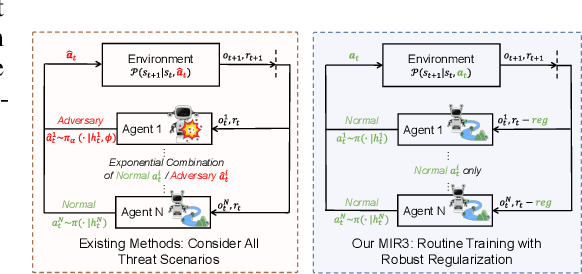



Abstract:Robust multi-agent reinforcement learning (MARL) necessitates resilience to uncertain or worst-case actions by unknown allies. Existing max-min optimization techniques in robust MARL seek to enhance resilience by training agents against worst-case adversaries, but this becomes intractable as the number of agents grows, leading to exponentially increasing worst-case scenarios. Attempts to simplify this complexity often yield overly pessimistic policies, inadequate robustness across scenarios and high computational demands. Unlike these approaches, humans naturally learn adaptive and resilient behaviors without the necessity of preparing for every conceivable worst-case scenario. Motivated by this, we propose MIR2, which trains policy in routine scenarios and minimize Mutual Information as Robust Regularization. Theoretically, we frame robustness as an inference problem and prove that minimizing mutual information between histories and actions implicitly maximizes a lower bound on robustness under certain assumptions. Further analysis reveals that our proposed approach prevents agents from overreacting to others through an information bottleneck and aligns the policy with a robust action prior. Empirically, our MIR2 displays even greater resilience against worst-case adversaries than max-min optimization in StarCraft II, Multi-agent Mujoco and rendezvous. Our superiority is consistent when deployed in challenging real-world robot swarm control scenario. See code and demo videos in Supplementary Materials.
Learning Joint 2D & 3D Diffusion Models for Complete Molecule Generation
May 21, 2023Abstract:Designing new molecules is essential for drug discovery and material science. Recently, deep generative models that aim to model molecule distribution have made promising progress in narrowing down the chemical research space and generating high-fidelity molecules. However, current generative models only focus on modeling either 2D bonding graphs or 3D geometries, which are two complementary descriptors for molecules. The lack of ability to jointly model both limits the improvement of generation quality and further downstream applications. In this paper, we propose a new joint 2D and 3D diffusion model (JODO) that generates complete molecules with atom types, formal charges, bond information, and 3D coordinates. To capture the correlation between molecular graphs and geometries in the diffusion process, we develop a Diffusion Graph Transformer to parameterize the data prediction model that recovers the original data from noisy data. The Diffusion Graph Transformer interacts node and edge representations based on our relational attention mechanism, while simultaneously propagating and updating scalar features and geometric vectors. Our model can also be extended for inverse molecular design targeting single or multiple quantum properties. In our comprehensive evaluation pipeline for unconditional joint generation, the results of the experiment show that JODO remarkably outperforms the baselines on the QM9 and GEOM-Drugs datasets. Furthermore, our model excels in few-step fast sampling, as well as in inverse molecule design and molecular graph generation. Our code is provided in https://github.com/GRAPH-0/JODO.
Towards Better Dynamic Graph Learning: New Architecture and Unified Library
Mar 23, 2023



Abstract:We propose DyGFormer, a new Transformer-based architecture for dynamic graph learning that solely learns from the sequences of nodes' historical first-hop interactions. DyGFormer incorporates two distinct designs: a neighbor co-occurrence encoding scheme that explores the correlations of the source node and destination node based on their sequences; a patching technique that divides each sequence into multiple patches and feeds them to Transformer, allowing the model to effectively and efficiently benefit from longer histories. We also introduce DyGLib, a unified library with standard training pipelines, extensible coding interfaces, and comprehensive evaluating protocols to promote reproducible, scalable, and credible dynamic graph learning research. By performing extensive experiments on thirteen datasets from various domains for transductive/inductive dynamic link prediction and dynamic node classification tasks, we observe that: DyGFormer achieves state-of-the-art performance on most of the datasets, demonstrating the effectiveness of capturing nodes' correlations and long-term temporal dependencies; the results of baselines vary across different datasets and some findings are inconsistent with previous reports, which may be caused by their diverse pipelines and problematic implementations. We hope our work can provide new insights and facilitate the development of the dynamic graph learning field. All the resources including datasets, data loaders, algorithms, and executing scripts are publicly available at https://github.com/yule-BUAA/DyGLib.
Conditional Diffusion Based on Discrete Graph Structures for Molecular Graph Generation
Jan 01, 2023



Abstract:Learning the underlying distribution of molecular graphs and generating high-fidelity samples is a fundamental research problem in drug discovery and material science. However, accurately modeling distribution and rapidly generating novel molecular graphs remain crucial and challenging goals. To accomplish these goals, we propose a novel Conditional Diffusion model based on discrete Graph Structures (CDGS) for molecular graph generation. Specifically, we construct a forward graph diffusion process on both graph structures and inherent features through stochastic differential equations (SDE) and derive discrete graph structures as the condition for reverse generative processes. We present a specialized hybrid graph noise prediction model that extracts the global context and the local node-edge dependency from intermediate graph states. We further utilize ordinary differential equation (ODE) solvers for efficient graph sampling, based on the semi-linear structure of the probability flow ODE. Experiments on diverse datasets validate the effectiveness of our framework. Particularly, the proposed method still generates high-quality molecular graphs in a limited number of steps.
GraphGDP: Generative Diffusion Processes for Permutation Invariant Graph Generation
Dec 04, 2022

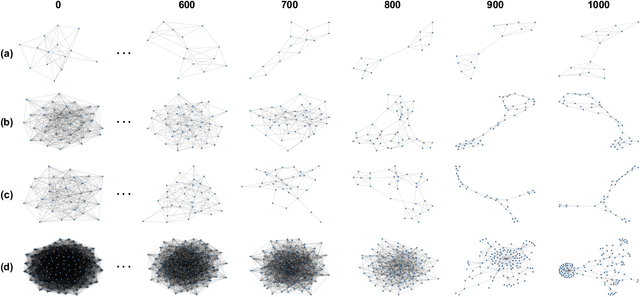

Abstract:Graph generative models have broad applications in biology, chemistry and social science. However, modelling and understanding the generative process of graphs is challenging due to the discrete and high-dimensional nature of graphs, as well as permutation invariance to node orderings in underlying graph distributions. Current leading autoregressive models fail to capture the permutation invariance nature of graphs for the reliance on generation ordering and have high time complexity. Here, we propose a continuous-time generative diffusion process for permutation invariant graph generation to mitigate these issues. Specifically, we first construct a forward diffusion process defined by a stochastic differential equation (SDE), which smoothly converts graphs within the complex distribution to random graphs that follow a known edge probability. Solving the corresponding reverse-time SDE, graphs can be generated from newly sampled random graphs. To facilitate the reverse-time SDE, we newly design a position-enhanced graph score network, capturing the evolving structure and position information from perturbed graphs for permutation equivariant score estimation. Under the evaluation of comprehensive metrics, our proposed generative diffusion process achieves competitive performance in graph distribution learning. Experimental results also show that GraphGDP can generate high-quality graphs in only 24 function evaluations, much faster than previous autoregressive models.
Continuous-Time and Multi-Level Graph Representation Learning for Origin-Destination Demand Prediction
Jun 30, 2022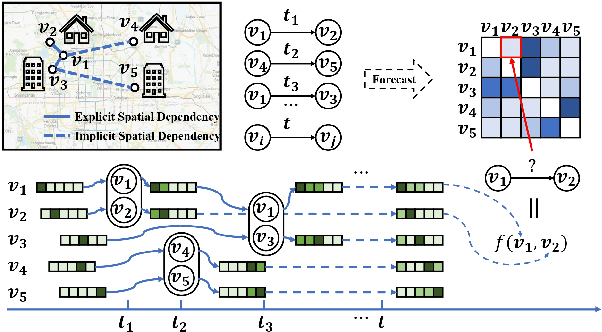
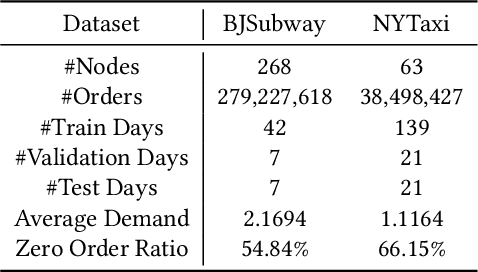
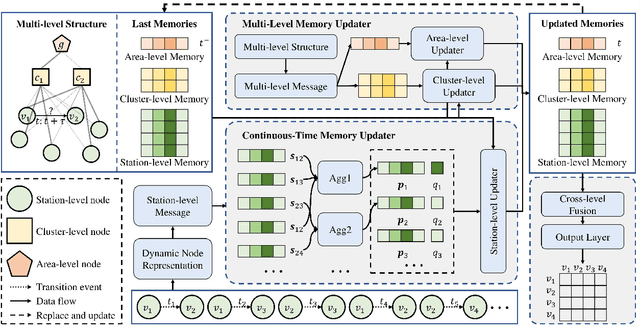
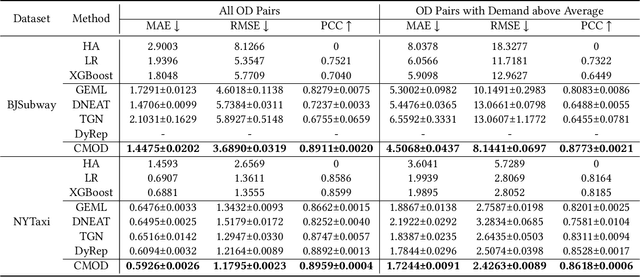
Abstract:Traffic demand forecasting by deep neural networks has attracted widespread interest in both academia and industry society. Among them, the pairwise Origin-Destination (OD) demand prediction is a valuable but challenging problem due to several factors: (i) the large number of possible OD pairs, (ii) implicitness of spatial dependence, and (iii) complexity of traffic states. To address the above issues, this paper proposes a Continuous-time and Multi-level dynamic graph representation learning method for Origin-Destination demand prediction (CMOD). Firstly, a continuous-time dynamic graph representation learning framework is constructed, which maintains a dynamic state vector for each traffic node (metro stations or taxi zones). The state vectors keep historical transaction information and are continuously updated according to the most recently happened transactions. Secondly, a multi-level structure learning module is proposed to model the spatial dependency of station-level nodes. It can not only exploit relations between nodes adaptively from data, but also share messages and representations via cluster-level and area-level virtual nodes. Lastly, a cross-level fusion module is designed to integrate multi-level memories and generate comprehensive node representations for the final prediction. Extensive experiments are conducted on two real-world datasets from Beijing Subway and New York Taxi, and the results demonstrate the superiority of our model against the state-of-the-art approaches.
Label-Enhanced Graph Neural Network for Semi-supervised Node Classification
May 31, 2022

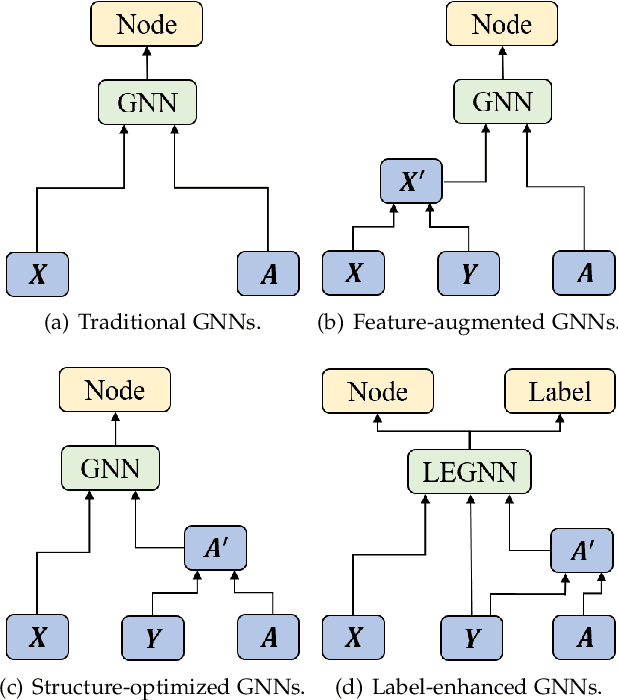

Abstract:Graph Neural Networks (GNNs) have been widely applied in the semi-supervised node classification task, where a key point lies in how to sufficiently leverage the limited but valuable label information. Most of the classical GNNs solely use the known labels for computing the classification loss at the output. In recent years, several methods have been designed to additionally utilize the labels at the input. One part of the methods augment the node features via concatenating or adding them with the one-hot encodings of labels, while other methods optimize the graph structure by assuming neighboring nodes tend to have the same label. To bring into full play the rich information of labels, in this paper, we present a label-enhanced learning framework for GNNs, which first models each label as a virtual center for intra-class nodes and then jointly learns the representations of both nodes and labels. Our approach could not only smooth the representations of nodes belonging to the same class, but also explicitly encode the label semantics into the learning process of GNNs. Moreover, a training node selection technique is provided to eliminate the potential label leakage issue and guarantee the model generalization ability. Finally, an adaptive self-training strategy is proposed to iteratively enlarge the training set with more reliable pseudo labels and distinguish the importance of each pseudo-labeled node during the model training process. Experimental results on both real-world and synthetic datasets demonstrate our approach can not only consistently outperform the state-of-the-arts, but also effectively smooth the representations of intra-class nodes.
 Add to Chrome
Add to Chrome Add to Firefox
Add to Firefox Add to Edge
Add to Edge